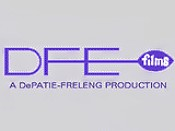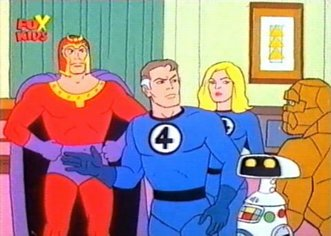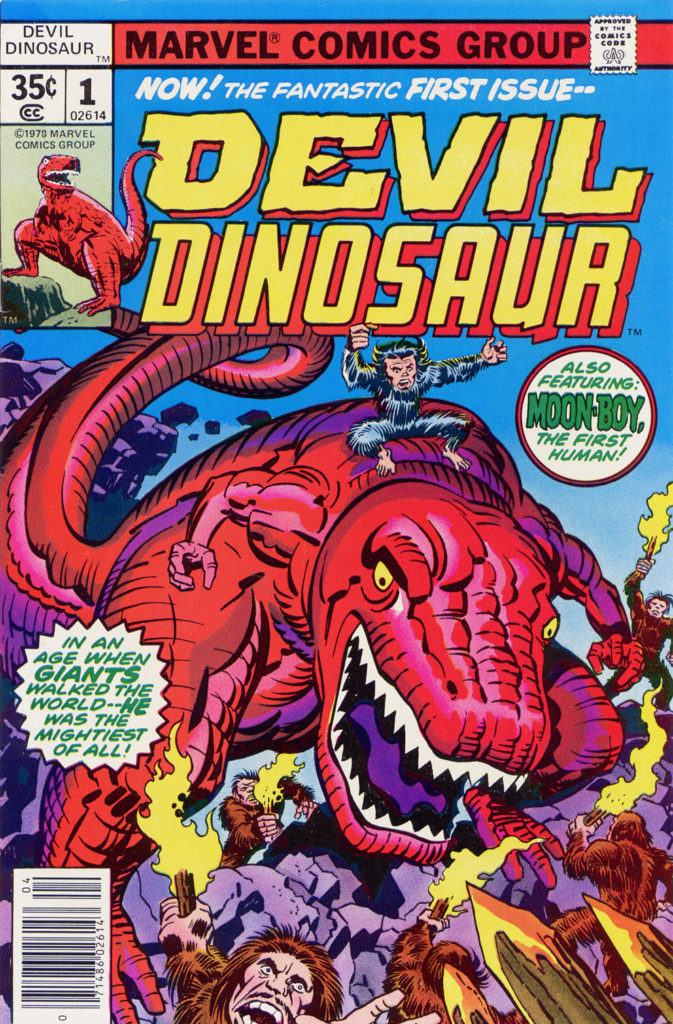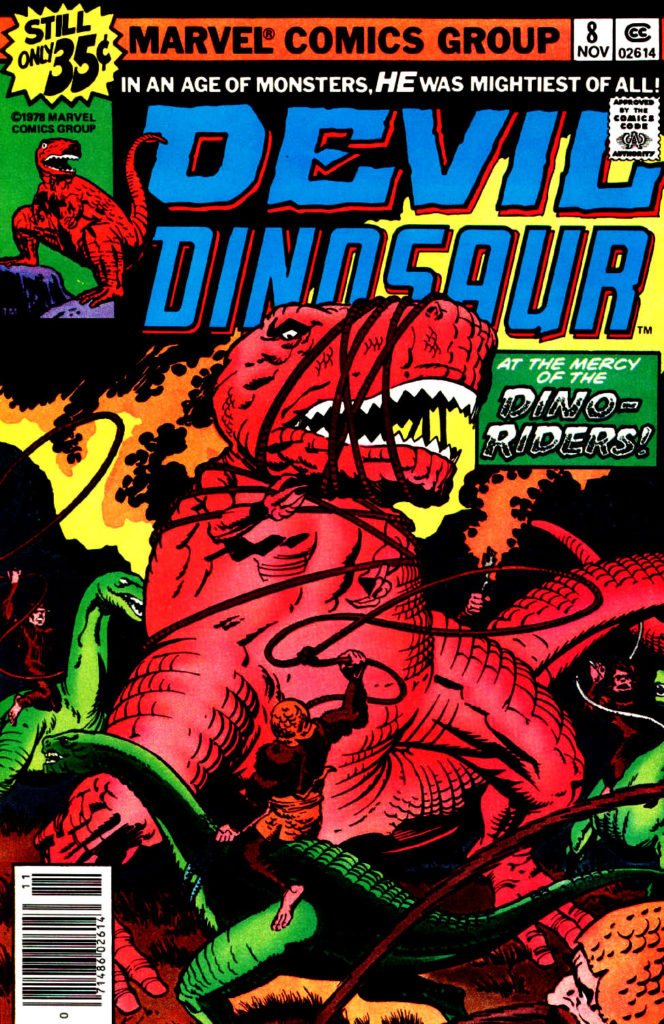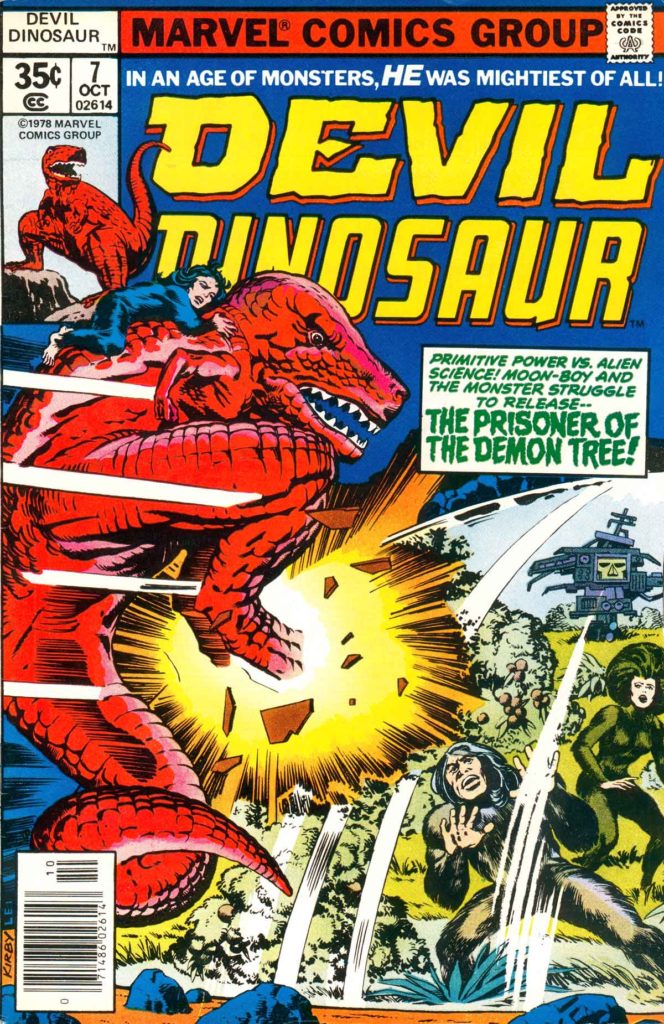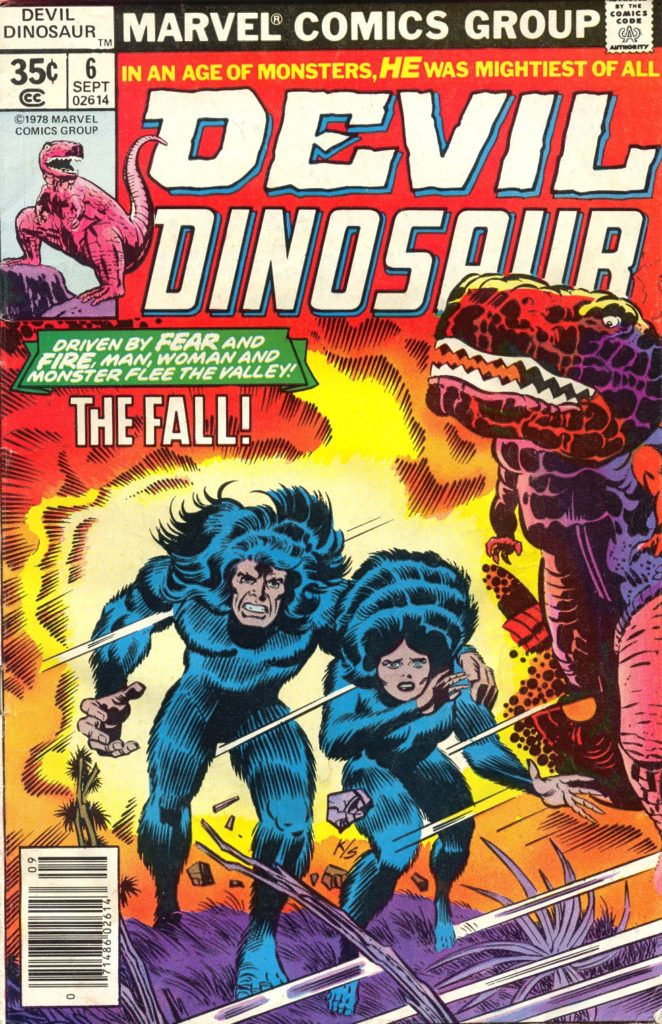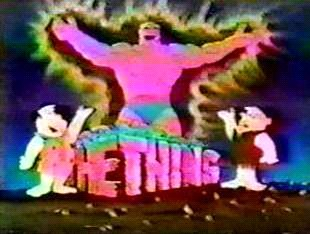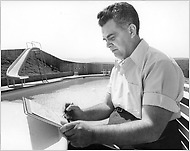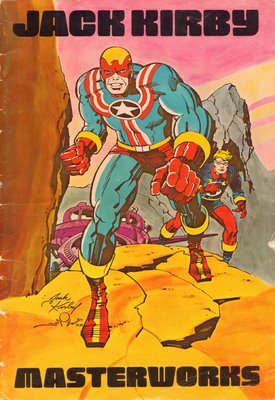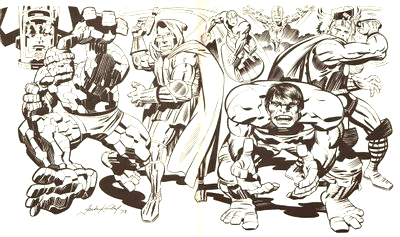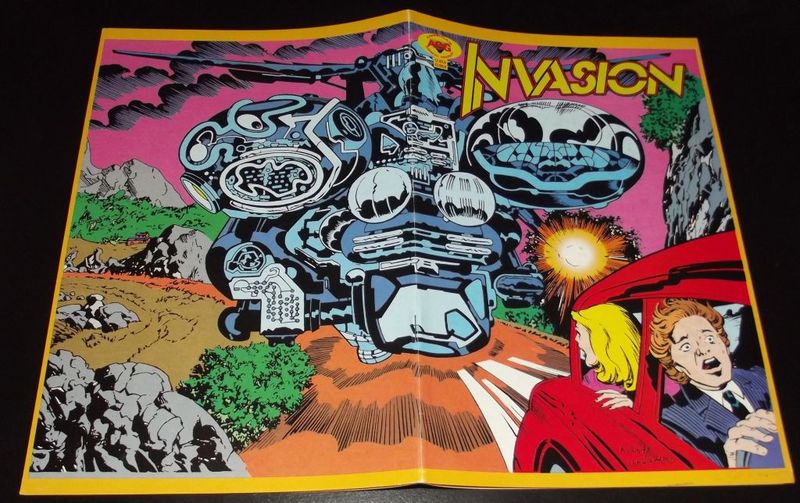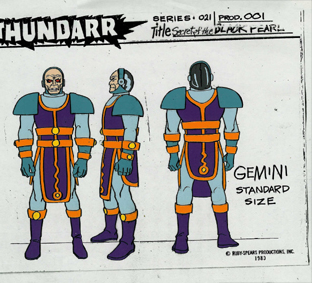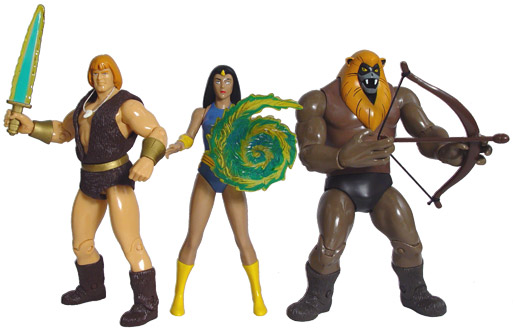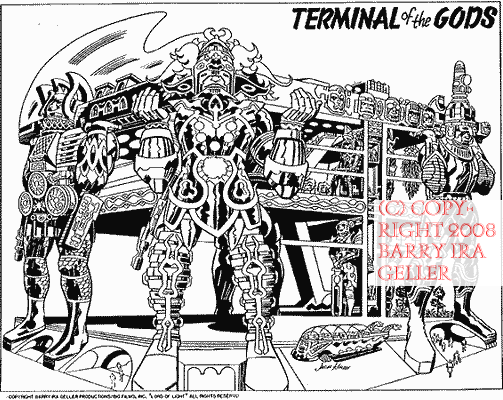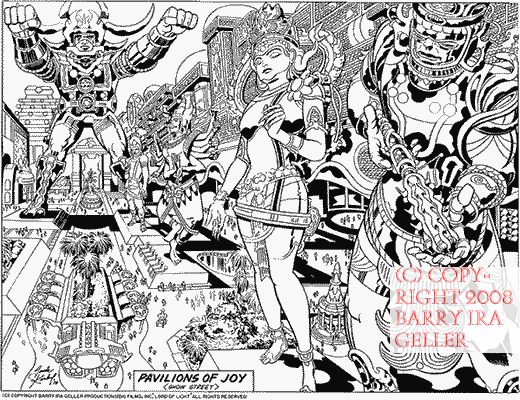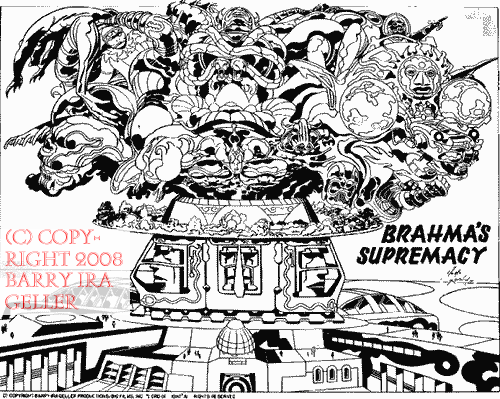Previous – 24. Once More Into The Breach | Contents | Next – 26. The Animated Artist
We’re honored to be able to publish Stan Taylor’s Kirby biography here in the state he sent it to us, with only the slightest bit of editing. – Rand Hoppe
ANIMATED

No one realized that Jack was having vision problems, and these problems sometimes skewed his perspective. His natural instincts corrected some of these problems and his inkers fixed what they could, but it was obvious that Kirby was slipping. His mind was as full of ideas as ever, but his ability to render the amazing was no longer strongly in his grasp. His problems with plot continuity continued as he raced from one amazing context to another. The many years of staring at an art board was taking its toll, not just physically, but mentally as well. Kirby didn’t have the strength to fight the system anymore. In a memorable dinner at a local dive, Jack talked to Mark Evanier of his future, bemoaning the fact that his contract was soon up and he couldn’t bear the thought of another tenure doing comics for a big impersonal comic house. Yet he had no alternatives. Then for perhaps the first time, instead of Kirby making his fortune, fortune found him.
Kirby did the thumbnails
In 1978, Marvel had leased to an animation company the rights to produce an animated Fantastic Four series. Someone suggested that since Jack Kirby was now living in California; why not get the original source to provide storyboards. A quick phone call from Hanna-Barbera Studios and Kirby was back where he had begun, working for an animation studio. Kirby and Marvel agreed that his working on the FF series would count toward the pages required of his contract so they had no problem, plus it took him away from the nitwits in the office who were jealous of him.
Suddenly Jack was out from under the yoke of deadlines and assembly line comic creation. Due to behind the scenes fighting, the project ended up over at the DePatie- Freleng studios and Stan Lee, who had recently moved to California to oversee Marvel’s cinematic properties, was brought in to help produce the toons while Kirby oversaw the art direction. Jim Shooter was upgraded to Stan’s publisher position. Under a strange agreement, the character of the Human Torch had been licensed to a different film
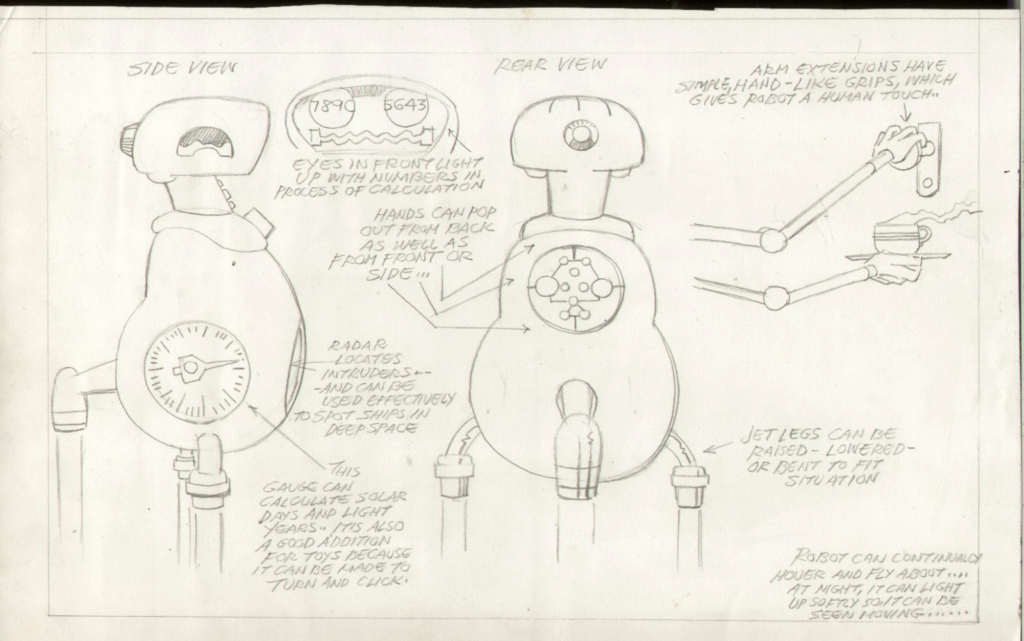
company, so the Torch was replaced in the cartoon by an irascible robot named Herbie. Some have speculated that it was a nod to Star Wars because of some similarities to R2-D2, others say that standards and practices rejected the Torch after a child had been burned while imitating the earlier cartoon. Neither seems to be true. The loss of the Torch really weakened some of the stories, especially in the visuals where the Torches flame was so visually exciting.
In FOOM #22 Marvel advertised the new show as if the impossible had been done, just their regular over the top huckstering. Complete with photos of Stan Lee and Jack Kirby and production drawings of Herbie the robot. (first called ZZ123)
“They said it couldn’t be done!
They said we couldn’t reunite the titanic talents of Stan Lee and Jack Kirby!
When we did that on the sensational all-new all-great Silver Surfer book from Simon and Schuster, they said we couldn’t come back to sweep Saturday morning TV with an animated Marvel feature series!
They were wrong!
Because Mighty Marvel is-as ever- on the move, and we’re making our push to become Masters of the Media! Yes, it’s true! In case you haven’t heard, faithful FOOMer, the Marvel Comics Group has just recently joined in pandemonious partnership with DePatie-Freleng, an awesome animation studio responsible for many of your favorite cartoon features.
The result is The New Fantastic Four Show, with rock ‘em-sock ‘em storyboards by King Kirby and slambang scripts by Stan the Man and others…”
The strip lasted just one season. Featuring 13 episodes of mostly dumb-downed, barely animated retellings of Fantastic Four comics.
To round out his soon to end contract, the last Kirby item was a series built around a big red dinosaur and the scruffy little kid who controlled it. Stan Lee heard that DC was pushing a Kamandi cartoon to CBS. Stan approached Jack about a similar child’s title that he might be able to pitch to animators. Devil Dinosaur was Kirby trying to regain the kiddie market–much like Kamandi had been an antidote to Kirby’s super-serious New Gods trilogy. Though childish in nature, Jack nevertheless delved into his vast cache of scientific knowledge. Jack explained; “One guy published a theory that we are descended from killer baboons.”

Jack was referring to what is called the Killer Ape theory as espoused by Dr. Raymond Dart, a noted anthropologist who proposed that man was evolved from bands of killer apes and that the aggressive behavior of man came from that natural need to kill for food. As layed out in his thesis in 1953, Dart’s ideas were met with disbelief and much curiosity. It became fodder for sci-fi writers and film makers. Books and movies such as Planet of the Apes, and the opening of 2001-A Space Odyssey borrowed heavily from Dart’s theories. Kirby had had a man vs. red dinosaur as early as 1961. Kirby had used pieces in books like 2001, Eternals, and Kamandi. “I believe that,…Forty years ago we just got through shoving people into ovens—on a very flimsy reason.” Kirby continued; “Man has a drive for domination” and Kirby extracted this and imbued it to his aliens. “The dinosaur was on Earth for 750 million years. Do you mean to tell me that it didn’t have the intelligence of …a dog? When I did Devil Dinosaur, I did a thinking dinosaur. My belief is that dinosaurs were intelligent. I mean, if we acquired the intelligence we have, say in a short period of about 4 million years, what might the dinosaur have accomplished in 750 million years?
The book was scoffed at by the older kids, but it was a great thrill ride for the kids. It was a cartoon in book form. Though never picked up by animation studios this series has become a cult classic, pure kitsch. Jack quit.
It was what it was
The finality of his decision hit Jack hard. Jack told Steve Sherman,” Fine, I’m done!
I get a pension, I get health benefits, I get treated like a human being.” “That’s it with comics. OK I’m done.” Mostly trying to convince himself. A lifetime of putting pencil to paper ended with a suddenness unimagined, but not unwelcome. With the end of his contract in mid-1979, his time at Marvel was through. He would now devote the rest of his career on animation presentations; with a detour or two along the way. But the tenure didn’t end on a happy note. The Fantastic Four cartoon series only lasted one year, but Stan Lee immediately followed this up with perhaps the ugliest, least inspired cartoon project ever.
Marvel leased the character of the Thing to another Hanna-Barbera animation project titled Fred and Barney Meet the Thing. Though the Stone Age duo never shared an episode with the Stone hero the concept is widely considered one of the worst cartoon shows ever created. Jack was unhappy as the habit of Marvel projects not crediting him with the creation of characters continued. Worse still is the abomination heaped on Kirby’s iconic character. Instead of the grumpy, anti-hero forever doomed to live in a rock-like exterior, the character is now a normal teenaged boy named Benjy Grimm who becomes a rocky super-hero when he touches two rings together and shouts “Thing rings-do your thing”.
Eeeeeeeeeeeeeeeewww! – Jack in 1971
Jack’s anger over Marvel’s refusal to list him as co-creator in such books as Origins of Marvel Comics and Sons of Origins plus credit for the Hulk and the Thing cartoon concretized into total disdain for Marvel’s practices. When asked if they could use his face on a proposed cover, Jack refused. In response to the growing disrespect, Jack made an agreement with Marvel to never use his likeness as a means of selling a book. If they wouldn’t credit him, he wouldn’t help them sell product.
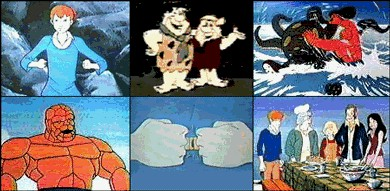
Another new portfolio of Jack Kirby’s artwork hit the stands when Privateer Press released The Jack Kirby Masterworks. With another short bio of Kirby by Mark Evanier, and dozens of large unpublished pages, rejected Marvelmania pages, and production pages done with loving care and a quality cover presentation showing a Kirby drawn Fighting American inked by Walt Simonson. It offered a great sweep of Kirby’s career. It also featured the first publishing of Kirby’s proposed Soul Love strip. It’s a wonderful adjunct to Jack Kirby Unleashed.
Original pencils from Jack Kirby Masterworks (1979) colored and reversed for Invasion #1 (1997 ACG)
In 1979, Disney Productions released a live action film called The Black Hole. It was Disney’s entry into the new burgeoning sci-fi genre started by Star Wars. It was common for Disney to also produce a Sunday newspaper strip of their current movie that ran under the title of Treasury of Classics. Mike Royer was working for Disney at the time and recommended Kirby for the job of producing the strip. Jack wasn’t busy so, after some negotiations, Kirby agreed. His job was to adapt the movie into cartoon format, over a certain period of time. It was most important for copyright and trademarks that the characters and concepts match up to those presented in the movie. Mike Royer was given the job to ink and maintain model consistency on Kirby’s pages. The movie was not a hit, but Kirby’s rendition is very true, plus more dynamic than the movie because of Jack’s bombastic style, and special effects techniques. What the movie and the strip adaptation lacked was a real climactic ending. When the spaceship tore through the Black Hole, there were no visuals depicting what the journey was like; nothing as memorable as the mind blowing visuals of 2001’s final star journey. It was a nice gig, and it allowed Kirby to keep his storytelling muscles toned. The strip ran for 26 installments-six months- Sept. 1979 to Feb. 1980, and was reprinted several times. Disney paid well for the strip.
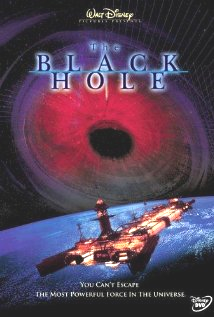
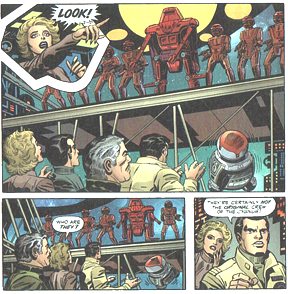
True to the source but anti-climactic
An entrepreneur approached about starting up a new comic’s line called Kirby Comics. Jack as usual threw his all in and produced a Graphic Novel-like presentation named Captain Victory. Like many times before the economic end fell through before actual publication.
Jack worked for DePatie –Freleng about a year when he got a call from Ruby-Spears, another animation house. Steve Gerber, a former writer at Marvel had pitched an idea for a cartoon called Thundarr the Barbarian, a mix of Conan, and Planet of the Apes. Mark Evanier recalls; “ABC was on the fence about buying the show.” Joe Ruby said we had to get more artwork done and Toth (Alex Toth) who designed the main character was not available.
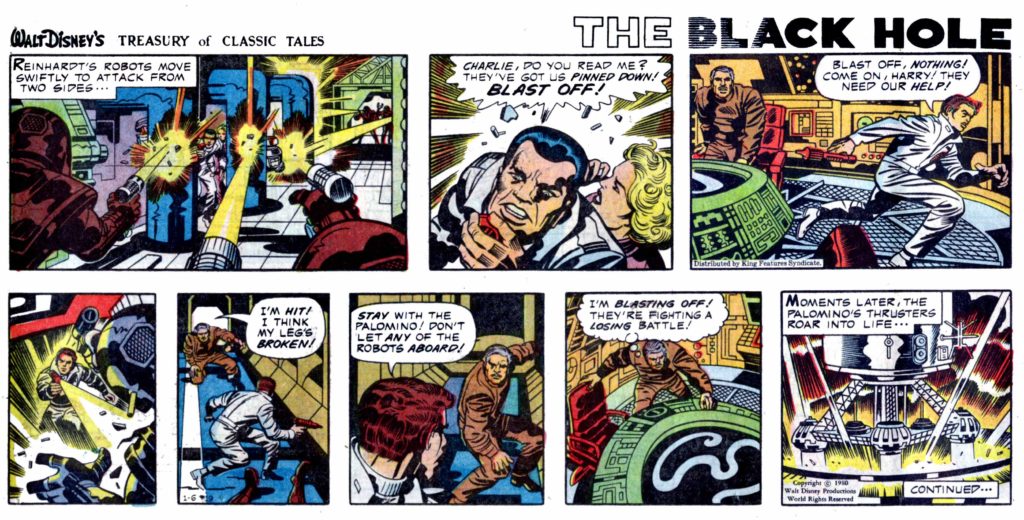
I recall saying, “Let’s get Jack Kirby.” So Jack did a bunch of big pieces of artwork, most of which were inked by Alfredo Alcala and that closed the sale with ABC.”
Jack and Alex Toth (rhymes with both) were friends and admirers whose approach to art and storytelling were 180 degrees apart—total opposites. Alex was born in New York 10 years after Jack and spent his early years bouncing between DC and some of the smaller companies; he had moved to California and found most of his work at Dell Comics and Charlton. He also worked for animators providing production designs and character creations with Space Ghost his most notable creation. To call him curmudgeonly is being nice to curmudgeons. Yet they were good friends and admirers who just couldn’t quite grasp the others genius. Once Alex went to a barbecue over at Jack’s house and spent the day talking with Kirby. When he left he told a companion that he didn’t know why he went, he and Jack have nothing in common. They would talk for hours at cross-purposes yet reach in many ways the same goal. Toth was cutting and gruff, while Kirby was a teddy bear of a man. Toth was minimalistic while Kirby became more detail obsessive with time. Toth was meticulous and technical, while Jack was spontaneous and free-wheeling. Toth was opinionated and hard to work with while Kirby was always polite and easy going and malleable with others.
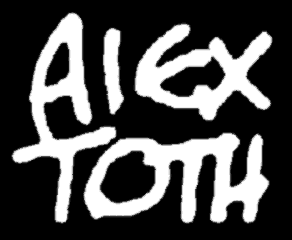
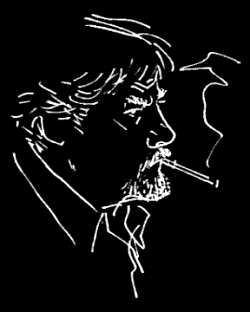
Flush from the sale of the series, there was talk of a Thundarr newspaper strip and Jack produced several weeks’ worth of continuity samples. It never came to fruition.
Joe Ruby described the genesis of the strip. “So I pitched the idea to ABC’s Marilyn Olin and Judy Price at the Beverly Hills Hotel from a list of about 15 ideas I had. Thundarr was pitched two ways- one a post-nuclear world, or a world destroyed by a natural disaster from space. We all agreed the first way wouldn’t be so good for kids. Well, after getting the development deal, I went about finding a development team of artists and a writer to work with me on the bible of the yet unnamed series. Alex Toth designed the three main characters (Jack Kirby later designed all the other characters after the series was sold) and Dave High designed the world they lived in, I considered two writers, and decided on Steve Gerber, who had done some scripts for us the year before.”
Joe Ruby always said that he envisioned this cartoon differently from the rest. He wanted a hard edge feel, full of dynamics, action, and drama rather than soft cuddly feel good graphics. They went back to an earlier animation technique. The army of horses and reptiles and rodents were rotographed using men on horsebacks to get the flow and motion of real movement. This technique started at Kirby’s earlier employer Fleischer Studio.
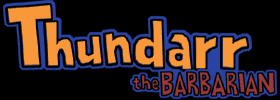
Gemini he of the two heads – Wonder if Kirby got royalties on the figurines
“I wanted to show things and be dynamic. I believe it was John Dorman who told me about a guy named Jack Kirby, who I hadn’t heard of, I’m ashamed to say. I was familiar with all his characters from eight years old, but I never knew Jack.” He came over; he was a giant of a man when I realized the characters he had created. But then I saw him, and he was an unassuming, very friendly, very cordial man. To me he almost seemed humble, and I thought, “Holy Cow, this is the man that did all those wonderful characters?” But anyway, I said “Okay, you’re hired.” “Jack wasn’t just an artist, he was a creator. He created very distinctive characters, people or creatures, whatever they were. He created with a story in mind. He would put story behind his creations. He had a philosophical view. Where are these characters coming from? that all came out on the paper. Jack had it. He had it all. And prolific! You’d ask for 2 or 3 pages, you’d get a stack. We put him under contract for six years.”
Ken Spears, the production end of the studio recalls, “Deep into this I start looking at the budgets and the costs, and I’m seeing this guy where all this money is going. So I go to Joe and I say. ”Who is this guy Jack Kirby, and why is he costing us so much?” He goes, “Well, he’s a great artist and he does all this stuff and he was a great Marvel artist.” “And blah, blah, blah.” So I go, “Okay great, how many weeks is he going to be working for us?” And Joe says, “I’ve got him under contract.” And I go, “Holy….are we going to be able to afford this?” “Oh don’t worry; he’s great he’s great.” And I’m thinking, how great could he be?” “But Jack was terrific; a wonderful guy and all I’ve got to say is, he gave me an opportunity to get a much lower price on our storage fees, because of the volume of work that this guy put out. It was absolutely incredible.”
Jack Kirby worked under a gentleman named John Dorman, the head of development for Ruby-Spears. It was John who recommended such people as Kirby and Gil Kane, and Jim Woodring. They were so close that they were named Dorman’s Los Angeles Bastards. Stories of John’s biting humor and caring nature abound. In addition to being a prolific and experienced creative talent, John Dorman was a near-mythic character with an epic sense of the absurd. He sprinkled his conversations with anecdotes of Jimi Hendrix, and sat spellbound sharing war stories with Jack Kirby. He was much more than a storyboard artist or art director, as anyone who worked for him in the early to mid 1980’s can attest. He was especially adept at helping gifted people (even a few legends) once their industry had hung them out to dry. In 1983 he paid a talented young storyboard apprentice named Dan Riba two hundred bucks over weekly union scale just because he knew that beginning wage was not enough to live on. Dorman was notorious in the industry for his sarcastic behavior as well as work habits and with his crew was oftentimes referred to simply as the “bastard”.
After John Dorman sadly passed, Dan Riba recalled. “The important thing is that John made me feel special, when I was feeling like a failure. He gave me the confidence to continue and learn. The main lesson I learned from John, was to treat artists with compassion. From giants like Jack Kirby, Doug Wildey and Gil Kane, to a beginner like me. We were all part of a creative fraternity different from the rest of the world. I believe that I’m a better supervisor, because of him. I will never forget the kindness that he has shown me.”
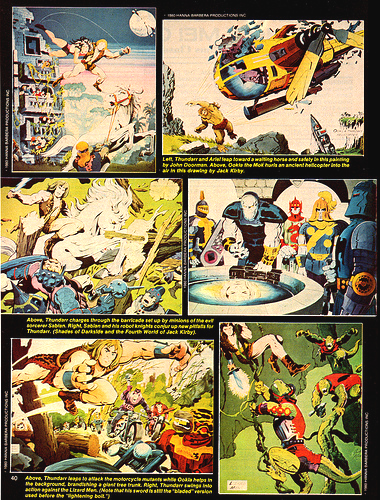
Kenny Thompkins (computer animator) added in. “I was also a part of the bastard crew. I came on after Thom Enriguez left. I shared a space with Ted Blackdude ( Blackman), that’s what I called him. One morning I heard screaming and cursing coming out of John’s office, so I’d ask Ted who John was cursing out, because it lasted about 20 minutes, with a phone slam to punctuate the conversation. I was new there, so I was kinda fearing for my job. Ted would just turn around calmly and say, “Oh, he’s just talking to the boss.” I thought if he talks to the boss like that, I hope I stay on his good side…. We all are a little crazy, that’s what this industry does to us. John just let a little leak out. We love you John, now you can go rock on with Jimi and go tell war stories with Jack. He was something!”
Buzz remembers an incident where the gruff storyboarder had the last word thanks to Jack Kirby. “While working on the animated Moses film, Prince of Egypt, John was assigned the task of storyboarding the parting of the Red Sea. The Exec in charge had some strong ideas how the story should be told, or rather, re-told. Specifically, to make it more “female friendly”, the Exec ordered the scene written with Moses’ wife breaking his staff across her knee & telling him to have faith in himself if he wanted to part the sea.
John was not a very spiritual, much less religious man, but he knew enough about the Bible to know camel dung when he smelled it. Still, a job was a job & John needed the money, so he storyboarded the scene as written…but he also “plussed” it a bit.
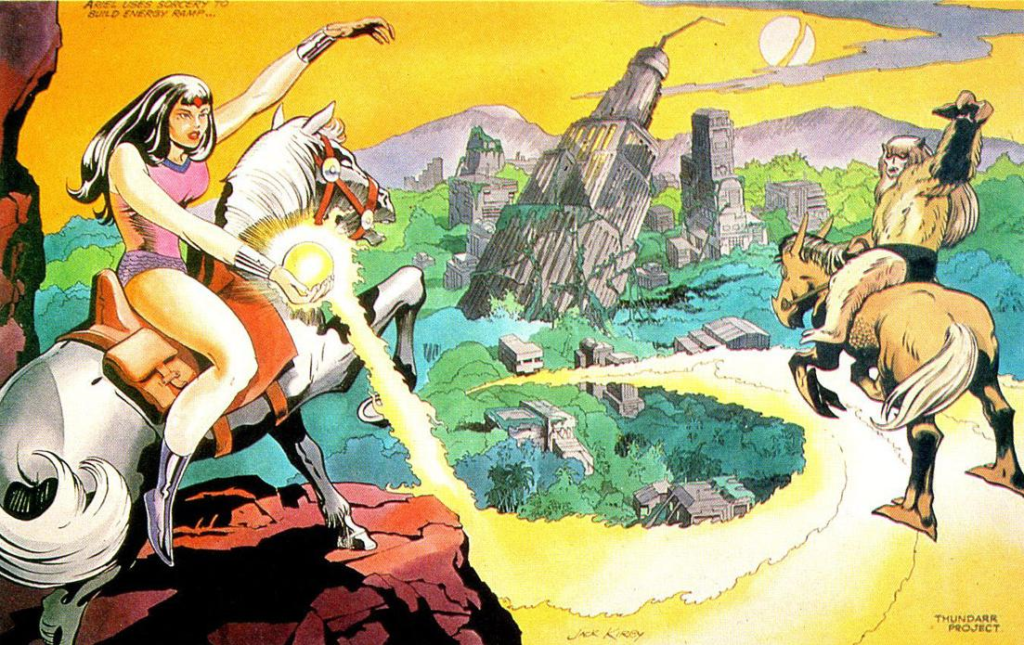
John turned the storyboard in and the Exec smiled at how well John had interpreted the Exec’s ideas, then noticed something and frowned. “This is all wonderful work,” the Exec said to John, “but who’s this figure here? the one in the cape with the horned helmet and a big hammer?”
“Oh, that’s Thor,” John said. “I figured since you were fucking around with the Bible I might as well throw him in.”
The Thundarr experience wasn’t totally happy for all. Steve Gerber talks about the step by step process of making a cartoon. “The final product often bears little or no resemblance to what the writer puts on the page. By the time a film or TV show gets to the screen, the writer has collaborated with literally hundreds of people, and a little of the original vision has gotten lost at each step between script and finished product. The writer writes, and then everybody else; the story editors, directors, producers, network executives, censors, actors in live action, storyboard artist in animation, gets to have ‘input.'” He called the final product a “bastardized version.” “The only thing that’s really better about working in TV than comics is the money…” Gerber griped that the Programs Practices people wouldn’t allow his barbarian, Thundarr, “to punch or to hit anybody. He can do all sorts of acrobatic things, but he can’t even trip anyone. We had to design a sword which was not a sharp object, which naturally led people to a laser sword. However, that had already been done before so we had to take it one step further to a lightning sword.” Thundarr was emasculated.”
With success, more work came Jack’s way; character designs, villains, machinery and such. Kirby stayed with Ruby-Spears. Jack worked on other shows such as Goldie Gold, and Action Jack, Mr. T, Rambo, Sectaurs and Chuck Norris Karate Kommandos. He also pitched in on a few Hanna-Barbera shows like Space Stars, and Super Friends: The Legendary Super Powers Show. Joe Ruby said; “We liked Jack’s work so much we put him on staff for six years. He was great.”
In late 1979 another unusual project grabbed Kirby’s attention. A movie producer named Barry Ira Geller had optioned the movie rights to a much touted sci-fi book named Lord of Light by Roger Zelazny. Geller had a grandiose idea of making a movie while at the same time building an amusement park from the movie props and settings. Geller approached Jack Kirby about doing some production drawings from which he could sell the idea to investors. Jack was also scheduled to be artistic director for the movie. Jack provided 13 of the most amazing epic sets ever imagined. They incorporated Mayan, Hindu and Eastern influences into the architecture, and seemed to rival the pyramids and Sphinx in scale and mass. The idea captured all the feelings that Kirby felt were embodied by comic work. It was powerful, imaginative and had a modern scope touching on tolerance, religion and the future. The business sales pitch was over the top:
From the Business Development section: “During the period of 1978-1980, professional associations included: a seasoned financial manager who managed four Studio heads, a Major Studio promise of distribution, an Oscar-winning actor’s promise of participation, an Oscar-winning Makeup Special effects director’s employment, the employment of the creative artist/designer responsible for 50% of the Comics Industry, two of the world’s top science fiction writers consulting, two of the world’s leading architects, and last but not least the personal involvement of one of the world’s most famous inventors. It was described as a property whose vast resources both creative and financial talent appreciated.”
I do like the part where the creative artist is credited with being responsible for 50% of the comic industry. Probably close. An example of how Geller and Kirby communicated: “Jack, I want to have something with 100-200 feet of revolving virtual image holograms of all the different people on the planet, and states of consciousness, and energies, and emotions”
Original Lord of Light – producer Barry Ira Geller
Then I said, “Let’s try it with just the revolving gardens” which is more like the novel. The novel doesn’t really say where anything is, so I took artistic license with it. And Kirby came back a week later with 2 pieces titled The Royal Chambers of Brahma. Kirby had looked for and finally found the awesome!
Kirby’s enthusiasm for the project was unparalleled. “Firstly, if I had not been invited to be involved with Lord of Light, I would have gone out of my way to make sure I could be.” This film is going to have a tremendous impact in the world, it will show enormous strength, it will allow the Eastern man and the Western man to relate to each other. And once mankind relates, they will never again have to fight. They will understand each other’s needs and idiosyncrasies.” I believe that this film and the way we are conceiving it could contribute to saving the world. I had to be involved…and I most definitely am.” His enthusiasm was admirable, his prescience not so well.
AWESOME!
On November 4, 1979 the country awoke to a shocking reality. Half a world away, fanatical followers of Ayatollah Ruhollah Khomeini had overtaken the country of Iran, and were holding 52 American hostages at the U.S. Consulate. Unknown was that six Americans had escaped and were in hiding, with Canadian assistance, hoping to be rescued.
A few weeks after the takeover, a message was slipped to the State Dept. acknowledging the hiding staffers and where they could be found for rescue. Tony Mendez, a former chief of the C.I.A.’s Disguise Section was given the task of coming up with a plan to sneak agents in to remove the six in hiding.
After a few days, Tony came up with an ingenious plan to pass off agents as location scouts for a Hollywood movie production, allowing them fairly free access through Iranian territory. For this to work, all the accoutrements of a Hollywood production would be necessary, first and foremost an actual movie prospectus to show the Iranians. His plan was nicknamed the Canadian Caper. Mendez knew they had to plan the ruse down to the last detail. “If anyone checks,” he said, “we need that foundation to be there.” If they were exposed, it could embarrass the government, compromise the agency, and imperil their lives and the lives of the hostages in the embassy. The militants had said from the beginning that any attempted rescue would lead to executions.
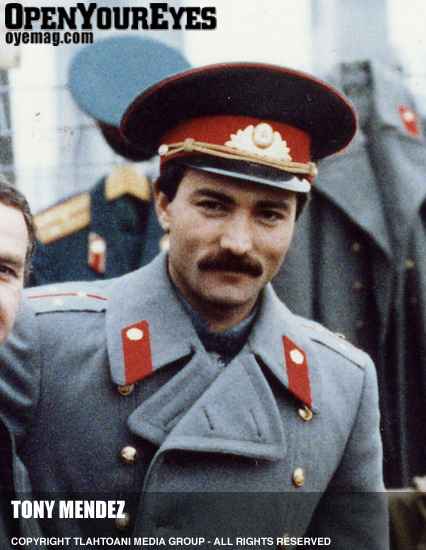
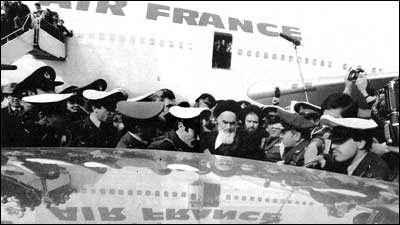
Ayatollah Khomeni
Mendez contacted a make-up designer in Hollywood who was well known to him from earlier escapades. This make-up man, John Chambers –of Planet of the Apes fame, had a clue for the perfect film prospectus. He had been among the first hired to work on Barry Ira Geller’s Lord of Light project. Since the production centered on a Middle Eastern location, the pictures fit the idea of using Iran for location shooting. When told of the project, the C.I.A. stole the script and production drawings from Geller’s Denver offices. It has been argued that the Lord of Light’s legal problem emanated from data stole by the C.I.A. backed D.A. office.
Tony gathered a core group and started “Studio Six” with the goal of entering Iran and extricating the hidden six. With his mission impossible cast of characters they set about setting up their cover story of making a movie named Argo. Mendez arranged for promotional ads in the Hollywood newspapers, and for business meetings and lavish parties announcing the movie beginning production. After considerable practice, The CIA men slipped into Iran, with Tony in the role of the exuberant Irish producer. “I have a business meeting with my company associates,” he explained to Iranian authorities in Germany. “They’re flying in from Hong Kong tomorrow and are expecting me.” Mendez had broken into a cold sweat in the airport — even professionals have their moments of doubt — but he knew there was no turning back. He put his faith in the strength of his cover story. That night the six escapees had dinner at a local residence of a Canadian friend, when Mendez arrived and told them they were to be secreted out of the country. They were told of the movie cover story and given new identification cards showing them as part of the movie production crew. They were given copies of the script and of Jack’s drawings as well as dummy contact phone numbers in case someone questioned their authenticity. When asked if they wanted to go individually, or together, the small group chose to stick together. They were also given special fake Canadian passports; not really fake since the Canadian government had them specially printed for the rescue mission.
The morning of Jan. 28, they made way to Mehrabad Airport. The airport had become chaotic since the revolution. The worst part was the Revolutionary guards who continually harassed passengers they thought might be smuggling riches out of the country. But that morning seemed calm. There were komitehs at customs, but their attention was focused on locals trying to smuggle out rugs or gold. Mendez had picked the early morning because by 10 am, Mehrabad would become a chaotic developing-world transit hub, with disordered lines of people, commotion, yelling, and shoving. That’s when the Revolutionary Guard would show up to have their run of the place. Mendez had gone ahead. His office had been testing out Mehrabad, sending agents to enter and exit the country, checking the security. But he preferred to see things for himself. Mendez could tell instantly if things felt right. He’d assess the customs and immigration desks — how diligent, for example, was the staff? More worrisome than the professionals were the komiteh and Revolutionary Guards standing behind them. Armed and unpredictable, they made the airport truly dangerous. Mendez led the way, running interference for the frightened passengers, talking to anyone nearby in a typical Hollywood b.s. fashion if they came too close.
“Tony recalls; The Iranian official at the checkpoint could not have cared less.” Some Iranian Revolution Guards had arrived and began harassing people. There was a heart pounding mechanical delay that shook everyone’s nerves. Just as the Guards started to bother the international passengers, they announced boarding to begin for the Swissair flight to freedom. Though it seemed interminable, departure and takeoff went smooth. Once the bar opened on the plane, Mendez dropped the charade and ordered Bloody Mary’s for all and raised a toast. “We’re home free”
The dramatic rescue was a success; the six arrived safely and were reunited with their families. A few months later, there was a military attempt at rescuing the 52 hostages at the Embassy. That rescue mission did not go so well when two Army helicopters crashed during a freak sand storm and the mission was aborted. Jimmy Carter’s presidency never recovered. Mendez met with President Carter in a small secluded non publicity setting; Carter thanked him for his heroism. Mendez received the C.I.A.’s Intelligence Star award and John Chambers was given a Medal of Merit.
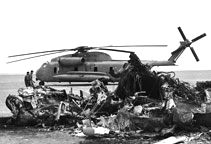
The depth of the extrication only became known to many in 2000, when a TV show interviewed Mendez, and got permission from Geller to use the artwork. In this interview Mendez openly admitted the theft of the script and artwork, to help in one of the great adventure stories.
As for the Lord of Light project, unfortunately there were some legal problems, and the project was shut down by the Gov’t. Later, in 1980 Prevue Magazine reported about a growing scandal involving real estate fraud, and misappropriation of funds. Several members were indicted, but Barry Geller was cleared and left alone, his project in tatters. Jack was devastated. Mike Royer the inker for the Lord of Light production pieces says the whole CIA story was bullshit! But later facts back it up as real. Jack had a few other minor brushes with the CIA, such as a proposed flying jacket similar to the one on Jack’s Jacob and the Angel piece.
Jack Kirby never knew about how his drawings were part of a dramatic rescue of the six Americans. Yet I’m thinking he would have been proud; a little cosmic payback for the loss of his good friend Leon to terrorists. Ben Affleck is set to direct a movie based on this escapade.
Previous – 24. Once More Into The Breach | Top | Next – 26. The Animated Artist


